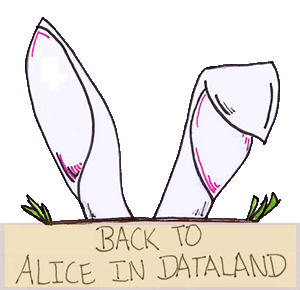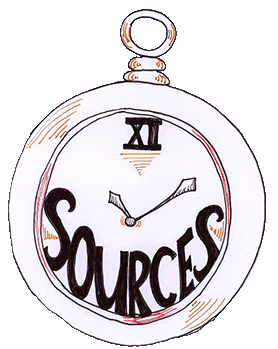

[Opening image text: (finding) Alice in Dataland: Part One: Down the Rabbit Hole...Anastasia Salter]
My childhood copy of Alice's Adventures in Wonderland opens with a now-familiar legend: three little girls went out in a boat with mathematics lecturer Charles Lutwidge Dodgson and listened to a story. One of those girls was named Alice Liddell, and the story told of another Alice's adventure.
Thus grew the tale of Wonderland:
Thus slowly, one by one,
Its quaint events were hammered out—
And now the tale is done,
And home we steer, a merry crew,
Beneath the setting sun.
Both idyllic origin myth and, through poetry, a frame for the final text, the story of that boat ride is one place to begin any exploration of Alice and her wonderland. The "real" Alice Liddell might be found on that boat, listener and protagonist, though we cannot know what she heard.
These first stories of Alice must make their own journey from orality to literacy before we as readers would know them. Many years later, you can take a boat ride down the canals of Oxford inspired by that "golden afternoon" (as I did) but come no closer to knowing Charles Lutwidge Dodgson the story-teller. His tales took a step closer to what Walter Ong calls the "finality" of print (if such a thing exists) when Dodgson wrote it down in the carefully handwritten and illustrated manuscript called "Alice's Adventures Under Ground"—itself delivered to the same Alice Liddell of the original audience.
The remediation of Alice's adventures begin with this move from the ephemeral of the oral to the concrete form of the written word—but this is far from where the transformation of Alice will end.
Lacking the ability to ever recover the original tales of Alice—rewritten as they are now by both storyteller and listeners, their ephemeral contents an inaccessible backbone of the Alice mythos—I am left with the "Alice's Adventures Under Ground" manuscript as an entrypoint to my search for Alice. Likewise, you are reading my own hand-written journal—or now, my transcription of that hand-written journal—the first of twelve mediums I'll be using to interrogate Alice wherever I find her. Alice has evolved repeatedly from the shapeless character of Dodgson's stories to the haunting photographs of Liddell as she aged to Tenniel's iconic illustrations and far beyond—to Disney and the abstractions of Mary Blair, to metaphorical kin of Neo in The Matrix, to iPad app star and video game murderess and beyond. Alice's identity is constantly re-embodied.
The same can be said for many still-iconic characters, including several who owe their birth to oral storytelling and fairy tales. But the nonsense of Alice continually probes at any media where she is reborn. If we follow Alice down the rabbit hole, can we find not only Alice but ourselves in the puzzling rules of Wonderland?
Details of any adaptation or remediation can transform a text: the very title of the "Alice's Adventures Under Ground" manuscript invites us to take the descent down the rabbit hole more literally. But as I write this, I'm not looking at the manuscript itself—I'm on the British Library website looking at the "Turning the Pages" virtual book version. Does it matter? You aren't actually reading this in my notebook either—I've scanned it in, and now I've retyped it while looking at the scan of my own journal page. Andrew Piper has explored the apparent "absence" of a book when it is removed from its physical body in this way, and there's a definite physicality to page-turning that is lost.
But when I pilgrimaged to see the manuscript in person at the British Library and peered at it through the glass I had even less of a chance to appreciate it as a text—though I did stand in awe of the handwriting for a long time. I can't even remember which page it was opened to because I was too busy seeing the lines to read the words.
already, we are stuck finding Alice through a digital window...
Several digital humanities scholars have already grappled with the lens of the digital archive. Alex Reid address the importance of the lens:
The digitization of traditional humanities objects is not a neutral process... one is actually studying a 21st century digital record.
When we first encouner Alice in her adventures "Under Ground", she is engaged in her own literary critique of the bound tome her sister is reading.
Where is the use of a book, thought Alice, without pictures or conversations?
The same sentiment is expressed when Alice moves into print, only "where" becomes "what." Following on this contemplation as a promise, the manuscript contains 37 illustrations and many more conversations. While these illustrations depict a girl with long, curly hair, there is an expression that draws to mind photographs of the young Alice Liddell. Many of the illustrations also contain blueprints for Tenniel's future iconic versions, such as the elongated Alice who takes up a full side of the page in the manuscript version. The transition from orality to literacy (to again invoke Ong) is embedded in these illustrations.
The first chapter of the manuscript chronicles (and is named for) Alice's tumble down the rabbit hole. The rabbit hole serves us as a metaphor for tumbling between mediums, from a wold of familiar rules to spaces where rules of logic and language are subject to being rewritten. Appropriately, Alice must reshape her own identity as part of passage through the "rabbit hole"—a term that has now become standard usage for the point of entry for "alternate reality games" that overlay unexpected narratives with the so-called real world. Upon landing in her rabbit hole, Alice is presented with a door too tiny for her physical body—and a transformative bottle labled only "Drink Me."
I can't imagine a more appropriate starting point for so many media journeys—particularly when we consider the impact of digitization while gazing at a manuscript that has itself been dis- and re- embodied. Just as Alice will quickly confront the physical consequences of her transformation as she continues down the rabbit hole and further "under ground," so too will we see Alice change as she moves out of the shadow of Alice Liddell and is "born-again"—digital.
Likewise, the rules of Wonderland offer a metaphor for understanding each new Alice as the product of its own technology with corresponding rules and structures. The deeper down the rabbit hole we follow Alice (and the elusive White Rabbit) the more of these platforms we can expose.
[closing image text: (find alice)]